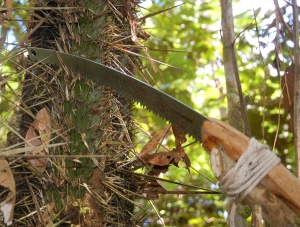
Bora artisan planting chambira seedling in 2013. Photo by Campbell Plowden/CACE
We have had growing success helping artisans in the Ampiyacu develop and market innovative handicrafts, but our efforts to catalyze significant reforestation of chambira palms used to make woven crafts has been frustratingly slow. While we have also promised to reinvest part of our craft sales in the US to support health, education and conservation needs in the communities, this social rebate program had unfortunately created more dissension than good works for several years.

Bora artisan planting chambira seedling in 2013. Photo by Campbell Plowden/CACE
While mentally prepared to confront the same resistance, I decided to at least try a fresh approach while meeting with our artisan partners in Brillo Nuevo. As they trickled in to our house at the far end of the village, they saw a written agenda posted on the wall. Noting the ambitious list included numerous updates and serious topics, they favorably commented that it also included slots for receiving certificates, donated clothing, and lunch.

Caimans and frogs game with Brillo Nuevo artisans. Photo by Campbell Plowden/CAC
Since discussions of tough issues in previous meetings had sometimes produced more rancor than resolution, we also inserted a few cooperative games into the mix. These were a balloon race which generated lots of laughs and an energetic round of caimans and frogs which featured artisans (as the frogs) holding on to each other on sheets of paper (representing tree stumps in a river) so the hungry caiman (the Amazon version of an alligator) wouldn’t get them when he woke up.
The results of the meeting included new agreements regarding craft pricing, quality control, a household survey, and a proposal for chambira reforestation.

Chambira “minga” with Brillo Nuevo artisans (2013) P
Three days later, the full community endorsed the reforestation plan. Brillo Nuevo would use a large chunk of its CACE social rebate fund to provide a standard “basket” of food (rice, beans, oil, etc.) for up to 20 families who wished to organize work parties (“mingas”) to help plant or do extensive maintenance on chambira, assai palm, or medical plants in their forest fields. Future rounds would allow more families to do the same. They also decided to use part of the fund to buy some critical supplies and medicines for the village health post that were not provided by the government.

Cutting chambira leaf spear with pruning saw. Photo by Campbell Plowden/CACE
When we headed back down the river to Puca Urquillo Huitoto, I was pleasantly surprised that their community meeting quickly agreed to also use their rebate fund to carry out 10 chambira work parties to replenish supplies of this vital plant for their artisans. Another part of improving chambira management will be providing pruning saws that can be used to harvest leaf-spears without damaging adjoining stems as often happens when the task is done with a machete.
I was astounded when the leader of the Puca Urquillo Bora council handed me a 3 page proposal requesting our assistance to fund enrichment planting of chambira in 30 hectares of fallow forest fields. Their decision was particularly surprising to me since they had rejected the offer of a researcher last year to measure the abundance of chambira palms in their fallow fields as we had done with artisans at Brillo Nuevo.
I have no illusions that these plans will be carried out without a hitch, but it was wonderful to feel this spiritual burst of affirmation to quench my growing wonder if some basic aspects of our work were seriously off-track.
******
CACE welcomes donations to this project through our page on GlobalGiving at: www.AmazonAlive.net


